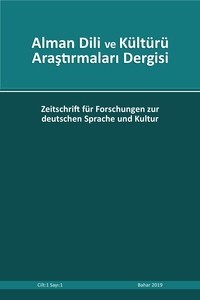Hartmann von Aue’nin “Der Arme Heinrich” Adlı Eserindeki Ana Motifler
Özet Alman Edebiyatı’nda 1170’den 1300 yılına kadar süren dönem Orta Yüksek Almanca dönemidir. Hartmann von Aue bu dönemin en önemli yazarlarından biridir. Saray Edebiyatı olarak da adlandırılan bu dönem Alman Edebiyatı’nın da ilk altın çağı olarak kabul edilir. Bu dönemde şövalyelerin oluşturduğu yeni bir sosyal sınıf ortaya çıkar. Şövalyeler, edebiyatı ruhban sınıfının tekelinden kurtarırlar. Saray hayatını yansıtan ve şövalye erdemlerini konu alan eserler ortaya koyarlar. Saray Edebiyatı dönemin Fransız Edebiyatı’nın etkisi altındadır. Efsanevi Kral Artur ve şövalyelerinin maceralarını konu alan Fransız romanlarını örnek alan Alman yazarlar Artur romanları olarak da adlandırılan birçok epik romanı kaleme alırlar. Birçok bakımdan dönemin öncülerinden biri olarak kabul edilen Hartmann von Aue Alman Edebiyatı’nın da ilk Artur romanını yazar. Üçüncü romanı ve nispeten diğer romanlarına göre daha kısa olan Der Arme Heinrich, konu bakımından da diğer Artur romanlarından ayrılır. Hartmann, bu eserinde doğrudan Tanrı insan ilişkisini ele alır. Kilise, ahiret hayatını öne çıkararak insanlardan dünya nimetlerinden feragat etmelerini talep ederken Saray Edebiyatı dünya hayatına büyük değer verir. Her iki kesimin beklentilerinin bir uyum, bir denge içinde olması gerektiğini düşünen Hartmann adı geçen eserinde bu sorunu işler. Kibri yüzünden Tanrı tarafından cüzzam ile cezalandırılan bir şövalyenin hikâyesini anlatırken ruhsal kurtuluşa giden yolun bu dünyadan geçtiğini hatırlatmaya çalışır. Hartmann’a göre insan her iki dünyada da başarılı olmak zorundadır. Eserinde bu sorunsallığı ele alan Hartmann birçok motif kullanmıştır. Ana motifler, dönemin Hıristiyanlık etkisini açıkça gösterir. Bu çalışmada ana motiflerin belirlenmesi ve kaynakların gösterilmesi amaçlanmaktadır. Bunun için de adı geçen eser içerik bakımından analiz edilerek bulgular ortaya konulmuştur. Anahtar Kelimeler: Hartmann von Aue, Der Arme Heinrich, Saray Edebiyatı, motifler Abstract The period from 1170 to 1300 in German literature is the Middle High German period. Hartmann von Aue is one of the most important authors of that time. This period, also known as court literature, is considered the first golden age of German literature. During this time, a new social class formed by knights emerged. Knights liberated literature from the clergy monopoly. They created works that reflect the life of the court and dealt with the virtues of knights. The Courtly Literature is influenced by the French literature of that period. The German authors, who take the example of French novels about the adventures of the legendary King Artur and his knights, wrote many epic novels, also known as Artur novels. Hartmann von Aue, who is considered as one of the pioneers of the time in many respects, also wrote the first Artur novel in German literature. The third novel of the author, Der Arme Heinrich, which is relatively shorter in comparison to his other novels, differs thematically from other Artur novels. In this work, Hartmann deals directly with the relationship between God and man. Courtly literature values world life, while the Church asks people to give up worldly life by emphasizing the hereafter. Hartmann, who believes that the expectations of both sides should be harmonious and balanced, addresses this problem in his work. While telling the story of a knight punished by leprosy for his arrogance, he tries to remind that the path to salvation is through this world. According to Hartmann, you have to be successful in both worlds. Hartmann, who dealt with this problem in his work, used many motifs. The main motifs clearly show the Christian influence of the time. The purpose of the present study is identifying these main motifs and showing the sources. For this purpose, the content of the work mentioned was analysed and the results were presented. Key Words: Hartmann von Aue, Der Arme Heinrich, Courtly Literature, motifs
Anahtar Kelimeler:
Hartmann von Aue, Der Arma Heinrich, Saray Edebiyatı, motifler
___
- Kaynakça
- De Boor, Helmut (1991): Die höfische Literatur, Vorbereitung, Blüte, Ausklang 1170 – 1250. München: C.H.Beck.
- Freytag, Hartmut (2004): Hartmann von Aue, Armer Heinrich, 'Arbeits'-Übersetzung vom armen Heinrich. http://germanistik.doomby.com/medias/files/hartmann-von-aue-der- arme-heinrich-bokos-z1-.pdf sayfasından 12.02.2020 tarihinde erişilmiştir.
- Krause, Norbert (1994): “Die historischen Heilig-Blut-Schriften der Weingartener Klostertradition”. 900 Jahre Blutverehrung in Weingarten. Norbert Kruse und Hans Ulrich Rudolf. Sigmaringen: Jan Thorbecke Verlag. 77-123.
- Roßnagel, Frank (1996): Die deutsche Artusepik im Wandel. Die Entwicklung von Hartmann von Aue bis zum Pleier. Helfant Edition: Stuttgart.
- Sieburg, Heinz (2010): Literatur des Mittelalters. Berlin: Akademie.
- Verweyen, Theodor (1970): Der Arme Heinrich Hartmanns von Aue. München: Wilhelm Fink Verlag. Von Straßburg, Gottfried (2012): Tristan. Berlin: Insel.
- Wapnewski, Peter (1979): Hartmann von Aue. Stuutgart: Metzler.
- Wapnewski, Peter (1990): Deutsche Literatur des Mittelalters, Ein Abriss von den Anfängen bis zur Blütezeit. Göttingen: Vandenhoeck&Ruprecht.
- Weddige, Hilkert (2008): Einführung in die germanistische Mediävistik. München: Beck.
- Yalçınkaya Akçit, Betül (2017): “Erec ve Dede Korkut Kitabı’nda Erdem ve Kazanımlar”. International Journal of Language Academy, 5/6. 360-371
- Yılmaz, Yasemin (2019): “Hartmann von Aue'nin 'Der arme Heinrich' eserinde günah- kefaret-bağışlanma olgusu”. Rumelide Dil ve Edebiyat Araştırmaları Dergisi, 6. 411- 418.
- Zengin, Dursun (2011): Alman Edebiyatı. Başından 19. Yüzyıla Kadar. Edebi Devirler, Önemli Yazarlar, Eserleri ve Eserlerden Okuma Parçaları. Ankara: Pelikan.
- Yayın Aralığı: Yılda 2 Sayı
- Başlangıç: 2019
- Yayıncı: H. Kazım KALKAN
Sayıdaki Diğer Makaleler
Die Probleme beim Gebrauch von Präpositionalergänzungen im Deutschen und Türkischen
Hartmann von Aue’nin “Der Arme Heinrich” Adlı Eserindeki Ana Motifler
Humor im DaF-Unterricht und humoristische Elemente im Lehrwerk Studio d
Hasan Kazım KALKAN, Çınla ERÇOKLU
Almanya’da Yaşayan 3. Kuşak Türklerde Sık Kullanılan Kod Aktarım Türleri – Bir Söylem Analizi
A1 Düzeyindeki Almanca Öğrencilerinin Yazılı Ürünleri Üzerine Bir Hata Analizi
Die Heimatsuche von Sascha Muhteschem in Zafer Şenocaks Roman “Gefährliche Verwandschaft”
Türkçe ve Almanca Karikatürlerde Ünlemler: Dilbilimsel Bir İnceleme
